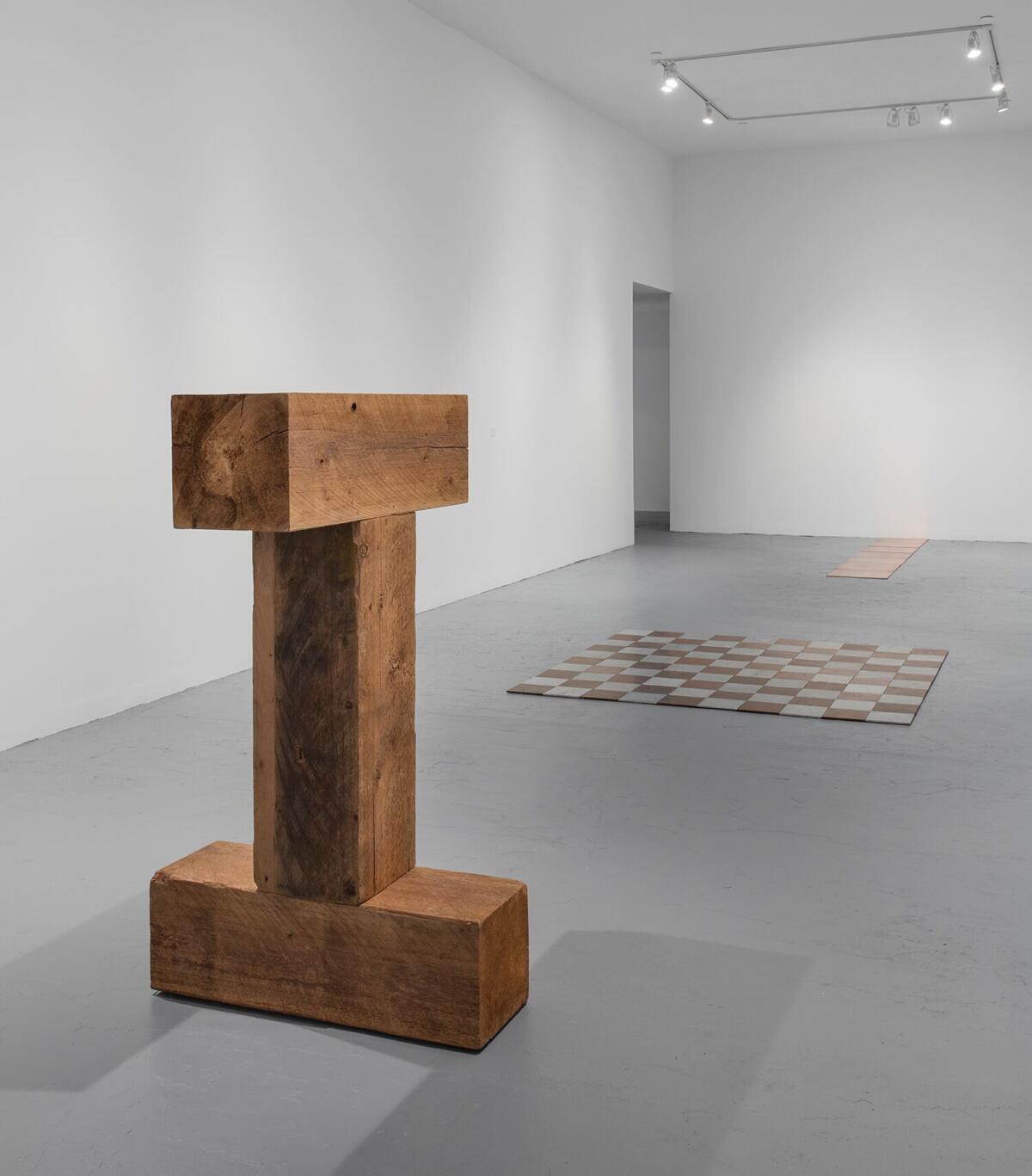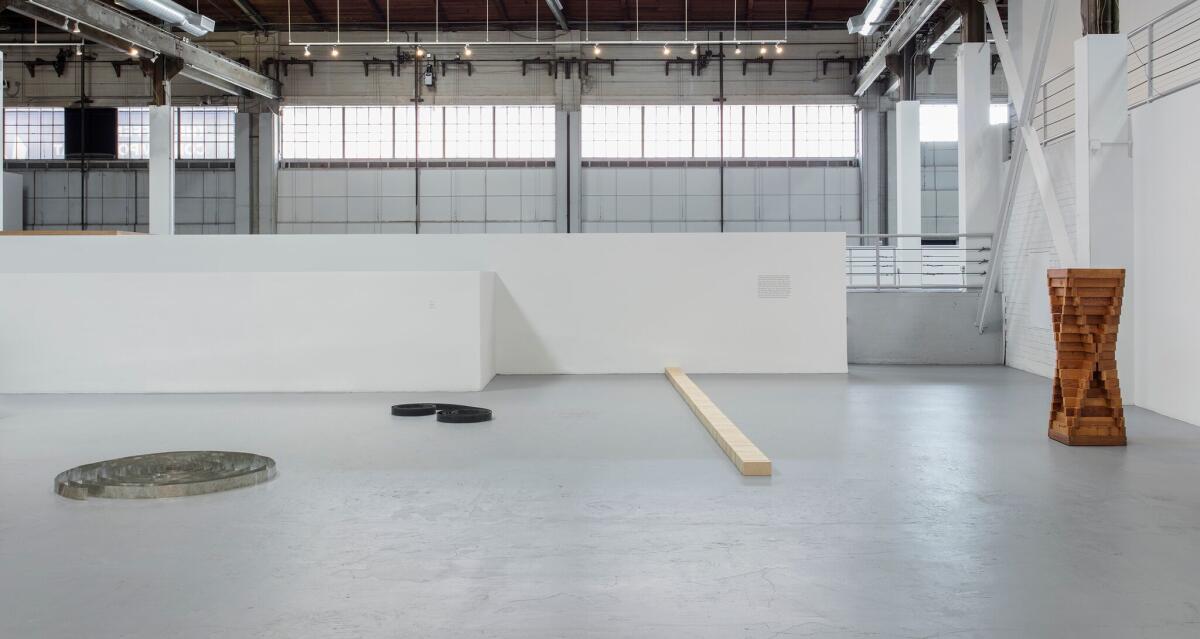Review: The exhibition that has art fans in a fury: Our criticâs take on MOCAâs Carl Andre retrospective
Carl Andre, whose retrospective of Minimalist sculpture is now at the
Some have been angered by his art. Others have been enraged by the person.
Emblematic of the former was the 1976 eruption of fury when Londonâs Tate Museum put his 1966 Minimalist sculpture âEquivalent VIIIâ on view. The work is a rectangular arrangement of 120 firebricks, the ordinary kind used to build fireplaces and furnaces. Theyâre placed on the floor in two layers, each one six bricks wide and 10 bricks long.
Thatâs it. No carving, no casting, no messy joinery.
Not since Marcel Duchamp, one of Andreâs idols, displayed a signed bathroom urinal as art in 1917 had a sculpture ignited such a ruckus. The brick rectangle became a focal point for public ridicule. Cartoonists in the popular press had a field day.
Almost a decade later, Andre faced a more serious situation.
Notoriously combative, he was charged with second-degree murder in the death of his wife, artist Ana Mendieta. In the small hours of Sept. 8, 1985, Mendieta plunged from the window of the coupleâs Greenwich Village apartment on the 34th floor. She was 36, he was 50.
Why protesters at MOCA's Carl Andre show won't let the art world forget about Ana Mendieta Âť
Not only were the circumstances surrounding the tragedy suspicious, but the police and prosecutorial work were a mess. (âNaked by the Window,â a 1990 book by the late investigative journalist Robert Katz, remains the definitive overview.) Andre, not exactly the art worldâs O.J. Simpson, nonetheless inspired staunch supporters and furious detractors. A judge acquitted the sculptor at trial.
When the MOCA Geffen show opened, protesters were on hand, determined to stand vigil in Mendietaâs memory. A generation has passed, but given lingering questions about the verdictâs justice, they were right to be there.
âCarl Andre: Sculpture as Place, 1958â2010,â the traveling exhibition organized by MOCA Director Philippe Vergne and Museum of Modern Art curator Yasmil Raymond, is also worthwhile. Not only has controversy over Andreâs work long since subsided â one critic has dubbed âEquivalent VIIIâ the most boring controversial artwork ever â the historical importance of his obdurate brand of sculpture is inarguable.
Since his 1988 acquittal, however, most museum presentations of his work have taken place in Europe. âSculpture as Placeâ did too, with New Yorkâs Dia Art Foundation (Vergne is former Dia director) and MOCA its only American stops.
The show is a pretty tight retrospective, apparently selected to yield a general sense of Andreâs aesthetic rather than chart specific developments. A sort of âreintroduction,â one could call it. There are 28 substantial sculptures, several of them made early in his career and then disposed of and remade later.

An Andre sculpture could be thrown out and remade later because there is nothing precious about his usual materials. Mostly geometric, they are insistently industrial, made from metals like iron, copper and magnesium and, if wood, hefty beams of plain red cedar.
Nor is the hand of the artist an intrinsic factor, the way it is for a sculptor who chisels marble, casts bronze or creates assemblages. Andre works with machined units, like metal plates and lumberyard timber. Phone the shop, order what you need.
You or I might make a convincing approximation of one down in the basement or out in the garage, but Andreâs come with a certificate of authentication. The artistâs hand signs it.
A submerged autobiographical element clings to the work. Andre is the son of a shipyard worker from Quincy, Mass., outside Boston, an industrial town with all the trappings of American Revolutionary history that the name implies. (Even the Quincy city seal is marked by a lone cedar tree rising on a hillside.) The artistâs materials and methods could be called egalitarian, since they dispense with artâs usual terms of establishment privilege.
My favorites are the checkerboard floor sculptures made from standardized metal plates. Theyâre horizontal rather than vertical, as sculpture is easily expected to be; a big square made from smaller squares, the whole greater than the sum of its parts; resting on the floor, just as we are, rather than elevated on a pedestal; and even meant to be walked on, violating every âdo not touchâ command that conventional art makes â especially when enshrined in a museum.
Constantin Brancusi considered the pedestal to be critically important to his sculpture, not merely a utilitarian stand, so he lavished as much attention on it as on everything else in his work. I like to think of Andreâs checkerboard floor pieces as carefully considered pedestals too â pedestals not for sculptures but for viewers. Standing on one, we donât look at the work as much as we look out from the place it makes for us.
Still, decades after my first encounter with one, it remains unnerving to step on an Andre floor piece in a museum. It seems such a violation of the rules. Surely a guard will intervene!
At the Geffen, labels indicate which sculptures may be walked on; those few that forbid it make their owners, apparently less concerned with art than with investment issues around virtually indestructible sculptures, look rather silly. Either way, Andre wins.
That the artistâs autobiography is submerged within the work, inessential to a viewer encountering the sculpture, is one reason for its revolutionary significance. Rather than a representation of the artistâs dynamic and expressive self, which was the norm in blustery American art after World War II, this work is an implacable object made to be experienced.

The sculptures take different forms, albeit all to the same ends. âLever,â one of his best-known works, is a plain line of 137 firebricks abutting a wall at one end and marching across the floor into the middle of the room. Itâs like Brancusiâs âEndless Columnâ of geometric blocks rising into spatial infinity â but tipped over, brought back down to earth.
âTau and Right Threshold (Element Series)â is composed of three chunky wooden beams of identical size and stacked atop one another. The horizontal floor beam runs east-west; on top of it in the center stands a vertical beam; on top of that is balanced another horizontal beam, but this one runs north-south. The simple composition, conceived in 1960, cleverly embraces the three-dimensional space of all the cardinal directions.
Sculpture as discrete mass unravels in enveloping space. Sculpture as a vertical figure rising from a horizontal earthly plane is upended. Sculpture as a modeled form disappears. Art as impassioned expression is neutralized.
The thing just stands there, as if daring you to dispute its status as a work of art. Tradition falls to pieces. The experience is oddly vivifying.
The letter âTauâ is an ancient Greek symbol for life or resurrection. Something like it turns up later in the show.
âEC.HO.â (1988) is a battered, industrial metal J-hook that hangs on the wall. Balanced on top is a simple piece of cardboard with the title spelled out in puncture marks.
It names Echo, the mountain nymph of Greek mythology who could not speak on her own but only repeat what she last heard. And it likewise refers to Ecce Homo â Behold the man â a common subject in Christian art. Ecce Homo represents the words spoken before the Crucifixion by Pontius Pilate as he presented the scourged body of Jesus to the mob.
So âEC.HO.â unites male and female. For me it also embodies the love-hate relationship of Andreâs public. The Greek myth of personal speechlessness, which corresponds with the sculptorâs inexpressive, just-the-facts-maâam artistic commitments, collides with an aggrieved story of persecution. More submerged autobiography: Made in the year of Andreâs murder trial, itâs a wince-inducing sculpture.
In addition to the major works, the show also includes a large quantity of Andreâs concrete poetry, most of it tedious, as well as several dozen clever table-top sculptures (they riff on Duchamp), diverse correspondence and other ephemera. Among the most telling is a 1977 postcard to critic Phyllis Tuchman; Andre castigates rival sculptor Donald Judd for working with volume, not mass, and smacks prominent art historian Irving Sandler, eloquent chronicler of Abstract Expressionism, who âlearns nothing and forgets nothing.â
The sentiments are combative remnants from a combative era in the hothouse New York art world. Radiating arrogance more than confidence, today they seem frail.
Andre was not alone in draining the art swamp of blowsy personal expression â a once-radical position that is now commonplace, verging on ubiquitous. His sculpture is powerful but narrow. Iâm glad the retrospective overview is here, and Iâm glad that it was greeted with protests.
âCarl Andre: Sculpture as Place, 1958â2010â
Where: Geffen Contemporary at MOCA, 152 N. Central Ave., L.A.
When: Through July 24; closed Tuesdays
Information: (213) 626-6222, www.moca.org
Twitter: @KnightLAT
ALSO
A groundbreaking show to confront the gender bias in art: 'Women of Abstract Expressionism'
Auction battles and encounters with royalty: LACMA curator looks back at 24 years of adventures
With bold brush strokes and luminous neon, L.A. painter Mary Weatherford comes into her own
Kerry James Marshall's paintings insist on black self-representation
The biggest entertainment stories
Get our big stories about Hollywood, film, television, music, arts, culture and more right in your inbox as soon as they publish.
You may occasionally receive promotional content from the Los Angeles Times.








